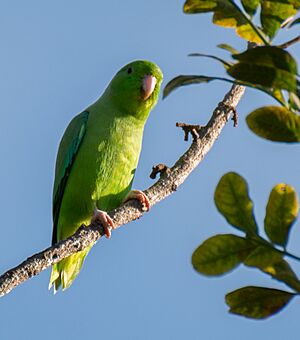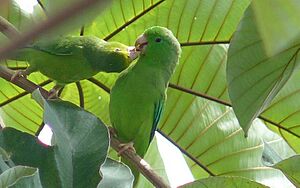Green-rumped parrotlet facts for kids
Quick facts for kids Green-rumped parrotlet |
|
|---|---|
 |
|
| Conservation status | |
| Scientific classification | |
| Genus: |
Forpus
|
| Species: |
passerinus
|
| Subspecies | |
|
|
 |
|
| Synonyms | |
|
|
The green-rumped parrotlet (Forpus passerinus) is a tiny, bright green parrot. It is also called the green-rumped parakeet. These small birds live in northeastern South America and on the Caribbean island of Trinidad. You can find them from northern Venezuela all the way to the lower Amazon River in Brazil. They also live in Suriname. People have brought them to places like Curaçao, Jamaica, and Barbados.
Green-rumped parrotlets like open areas that are not too high up. Sometimes, you can even spot them in city parks! There are five different types, called subspecies, of this parrotlet.
Contents
Understanding the Green-Rumped Parrotlet's Family Tree
Scientists give every living thing a special two-part name. This helps everyone know exactly which animal they are talking about. The green-rumped parrotlet was first officially described in 1758. A Swedish scientist named Carl Linnaeus gave it the name Psittacus passerinus. He wrote about it in his famous book, Systema Naturae.
Later, in 1858, a German zoologist named Friedrich Boie created a new group, or genus, for these tiny parrots. He called this group Forpus. Now, the green-rumped parrotlet is one of nine species in the Forpus genus. The name passerinus comes from Latin and means "sparrow-like," because they are small like sparrows.
There are five different types, or subspecies, of the green-rumped parrotlet:
- F. p. cyanophanes – found in northern Colombia
- F. p. viridissimus – found in northern Venezuela, Trinidad and Tobago
- F. p. passerinus – found in the Guianas (a region in South America)
- F. p. cyanochlorus – found in Roraima, which is in northern Brazil
- F. p. deliciosus – found in the lower Amazon River area of Brazil
What Does a Green-Rumped Parrotlet Look Like?
Green-rumped parrotlets are about 12 cm (4.7 in) (about 4.7 inches) long. They weigh between 20–28 g (0.71–0.99 oz) (about 0.7 to 1 ounce). Their feathers are mostly bright green. The back of their neck might look a bit duller or grayer. They have dark brown eyes and light peach-colored beaks and feet.
These parrotlets show sexual dimorphism. This means males and females look a bit different.
- Males have purplish-blue feathers on their wings. These blue feathers are on the main flight feathers and the feathers that cover them. They also have bright turquoise feathers on the front edges of their wings.
- Females do not have these blue colors. Instead, their heads have more yellow-green feathers.
Like all parrots, green-rumped parrotlets have special feet. They have two toes pointing forward and two toes pointing backward. This is called zygodactyly. It helps them grip branches and hold food. Young parrotlets, called juveniles, look like the adult birds.
Each subspecies has slight differences in their colors:
- The male of F. p. cyanophanes has more purple-blue markings on its wings.
- The male of F. p. viridissimus has darker purple-blue markings on some of its wing feathers.
- The male of F. p. cyanochlorus has darker purple-blue markings than the main type. The female of this subspecies is a brighter yellow-green.
- The male of F. p. deliciosus has a brighter emerald green back and rump, sometimes with a pale blue tint. Its wing feathers are pale blue with purple-blue near the feather shafts. The female of this subspecies has a more yellow forehead.
Where Do Green-Rumped Parrotlets Live?
Green-rumped parrotlets live in tropical South America. You can find them in the Caribbean parts of Colombia, Venezuela, and Trinidad. They also live south and east into the Guianas and Brazil, near the lower Amazon River.
They have been brought to Jamaica, Curaçao, Barbados, and Tobago. Interestingly, they were not seen on Trinidad before 1916. These parrotlets are one of only two parrotlet species found in the West Indies.
These birds are quite common in open, dry areas. They live in dry scrubland, forests where trees lose their leaves, gallery forest (forests along rivers), farmland, and areas where forests have been cut down. They do not migrate, meaning they don't travel long distances for seasons. However, they might move around locally to find food. You won't find them living in places higher than 1,800 metres (5,900 ft) (about 5,900 feet) above sea level.

Protecting Green-Rumped Parrotlets
We don't know the exact number of green-rumped parrotlets in the world. However, scientists say they are widespread and common. But there is clear evidence that their numbers are going down. This is probably because their homes are being destroyed by deforestation, which is when forests are cut down.
Even with this decrease, the IUCN Red List has classified the green-rumped parrotlet as a "Least Concern" species. This means they are not currently in danger of disappearing.
Green-Rumped Parrotlet Behavior and Life

Social Life of Parrotlets
Green-rumped parrotlets are very gregarious, which means they love to be in groups. They often gather together to sleep. You can often see them in flocks of up to 100 birds!
These parrotlets make soft, twittering sounds. When they are in large groups, their calls become louder. Each parrotlet has a unique contact call, almost like a special "name." They use these calls to recognize their mate. Each call is different in how long it lasts, its pitch, and how often it repeats.
Scientists have watched these parrotlets in flocks. They found groups with breeding pairs (a male and female who are raising babies), non-breeding pairs, male-male pairs, and single non-breeding males. The mix of these groups changes with the seasons.
Reproduction and Life Cycle
Green-rumped parrotlets form strong bonds with their mates. They usually stay with the same partner for one or two breeding seasons. If a parrotlet's mate dies, it will often find a new one. About half of widowed parrotlets will adopt the babies of their new partner. Male "stepfathers" often nest with their new mates. This can help them start breeding earlier than other males. This suggests that adoption might be a way for them to find a mate and have babies.
Almost half of wild female parrotlets try to have a second group of babies during the same breeding season. They usually breed during the rainy season, from May to November. However, different subspecies might breed in different months.
They typically build their nests in holes in trees. They also use holes found in termite nests in trees or in wooden fence posts. There is a lot of competition for good nest spots. Sometimes, non-breeding pairs will try to take over nests that are already being used. They might even kick out the babies that are already there.
The female lays 5 to 6 small white eggs. She lays them over 9 to 16 days. She usually starts sitting on the eggs (incubating) after the first egg is laid. This means the eggs hatch at different times. Hatching begins 18 to 22 days after she starts incubating. Depending on how many eggs there are, all the babies will hatch within 2 to 14 days after the first one. The young birds leave the nest (fledge) 29 to 35 days after hatching. All the babies from one group usually fledge over about 14 days.
The long time it takes for green-rumped parrotlet babies to grow in the nest might be because there isn't much food or minerals in their habitat. Because the babies hatch at different times, they are not all the same size. Parents feed the larger chicks more often. However, female parents are more likely to feed the smaller chicks first because they beg more. Larger chicks tend to be quieter. This behavior has been seen in other parrot species too.
Scientists have also found that female parrotlets gain a lot of weight before laying eggs. They can gain up to 25% more weight! They keep this extra weight until the eggs start to hatch. How much weight they lose after that depends on how many babies they are raising.
What Do Green-Rumped Parrotlets Eat?
Green-rumped parrotlets mainly eat seeds from grasses and other small plants called forbs. They also enjoy eating flowers, buds, berries, and fruits. They have been seen eating seeds from fruit trees like Annona species and guava.
Green-Rumped Parrotlets as Pets
Green-rumped parrotlets are sometimes raised by people and kept as pets. However, they are not as common as some other Forpus species. In the United States, it is against the law to bring wild green-rumped parrotlets into the country because of the Wild Bird Conservation Act. Other laws also limit international trade. This means that most pet parrotlets come from birds already bred in captivity.
Related Books and Articles
- Birds of Venezuela by Hilty, ISBN: 0-7136-6418-5


